Infraphylum Mycetozoa Family Physaraceae Higher classification Physarum | Genus Physarum Rank Species | |
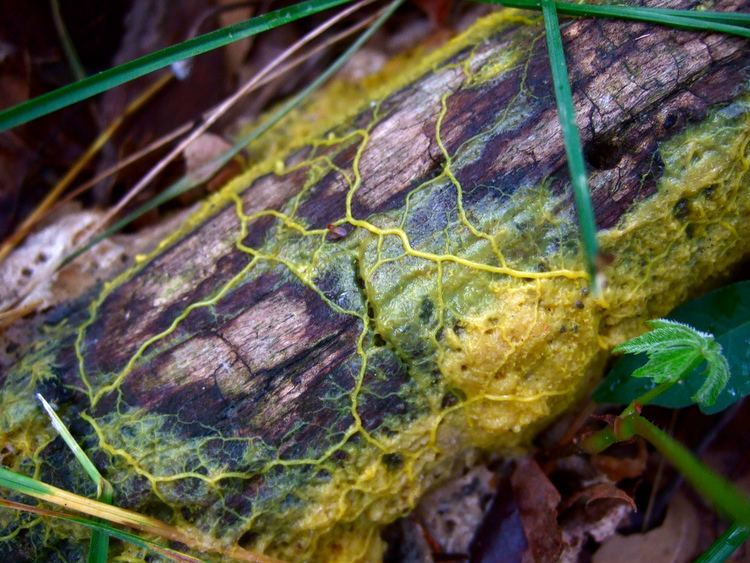 | ||
Similar Physarum, Mycetozoa, Myxogastria, Eukaryote, Dictyostelium discoideum | ||
Physarum polycephalum 1
Physarum polycephalum, literally the "many-headed slime", is a slime mold that inhabits shady, cool, moist areas, such as decaying leaves and logs. Like slime molds in general, it is sensitive to light; in particular, light can repel the slime mold and be a factor in triggering spore growth.
Contents
- Physarum polycephalum 1
- Slime mold physarum finds the shortest path in a maze
- Characteristics
- Life cycle
- Streaming behavior
- Situational behavior
- References
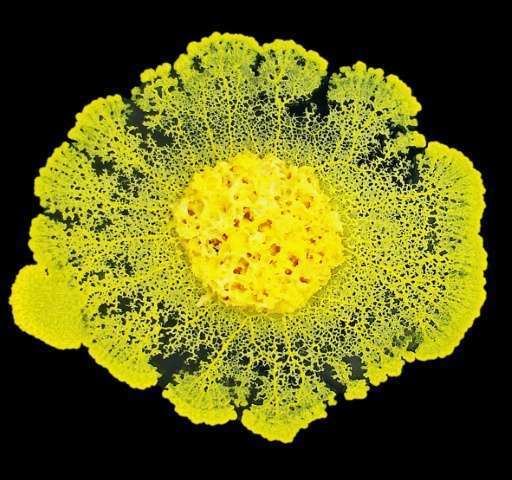
Slime mold physarum finds the shortest path in a maze
Characteristics
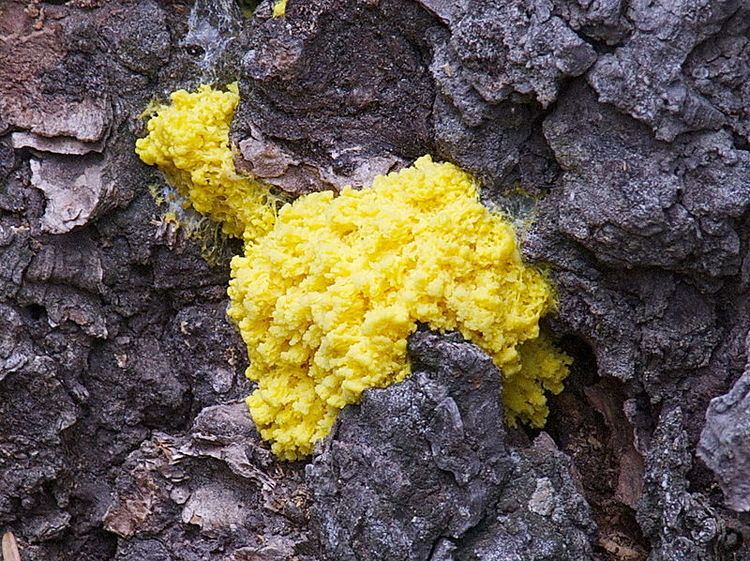
This protist may be seen without a microscope; P. polycephalum is typically yellow in color, and eats fungal spores, bacteria, and other microbes. P. polycephalum is one of the easiest eukaryotic microbes to grow in culture, and has been used as a model organism for many studies involving amoeboid movement and cell motility.
Life cycle
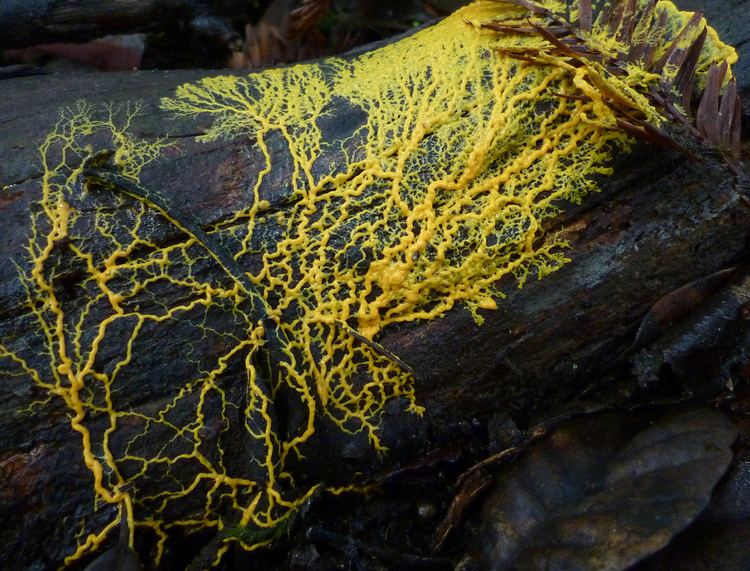
The main vegetative phase of P. polycephalum is the plasmodium (the active, streaming form of slime molds). The plasmodium consists of networks of protoplasmic veins, and many nuclei. It is during this stage that the organism searches for food. The plasmodium surrounds its food and secretes enzymes to digest it.

If environmental conditions cause the plasmodium to desiccate during feeding or migration, Physarum will form a sclerotium. The sclerotium is basically hardened multinucleated tissue that serves as a dormant stage, protecting Physarum for long periods of time. Once favorable conditions resume, the plasmodium reappears to continue its quest for food.
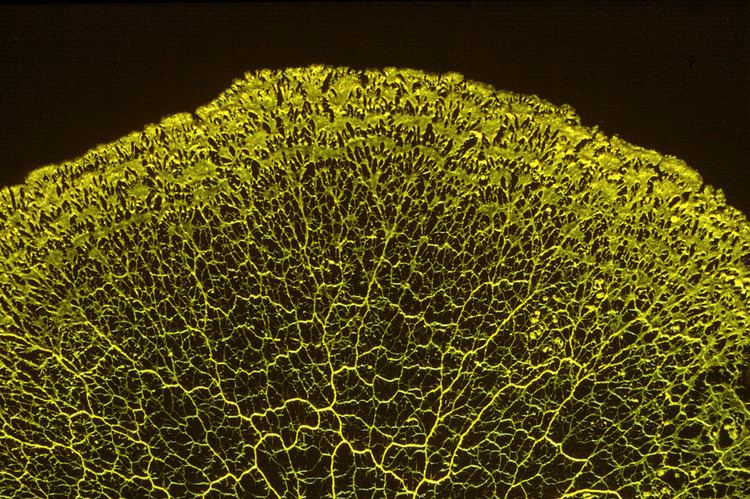
As the food supply runs out, the plasmodium stops feeding and begins its reproductive phase. Stalks of sporangia form from the plasmodium; it is within these structures that meiosis occurs and spores are formed. Sporangia are usually formed in the open so that the spores they release will be spread by wind currents.
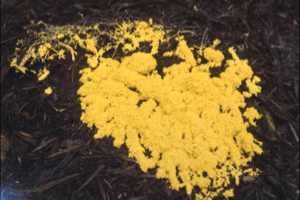
Spores can remain dormant for years if need be. However, when environmental conditions are favorable for growth, the spores germinate and release either flagellated or amoeboid swarm cells (motile stage); the swarm cells then fuse together to form a new plasmodium.
Streaming behavior
The movement of P. polycephalum is termed shuttle streaming. Shuttle streaming is characterized by the rhythmic back-and-forth flow of the protoplasm; the time interval is approximately two minutes. The forces of the streaming vary for each type of microplasmodium.
The force in amoeboid microplasmodia is generated by contraction and relaxation of a membranous layer probably consisting of actin (type of filament associated with contraction). The filament layer creates a pressure gradient, over which the protoplasm flows within limits of the cell periphery.
The force behind streaming in the dumbbell-shaped microplasmodia is generated by volume changes in both the periphery of the cell and in the invagination system of the cell membrane.
Situational behavior
Physarum polycephalum has been shown to exhibit intelligent characteristics similar to those seen in single-celled creatures and eusocial insects. For example, a team of Japanese and Hungarian researchers have shown P. polycephalum can solve the Shortest path problem. When grown in a maze with oatmeal at two spots, P. polycephalum retracts from everywhere in the maze, except the shortest route connecting the two food sources. When presented with more than two food sources, P. polycephalum apparently solves a more complicated transportation problem. With more than two sources, the amoeba also produces efficient networks. In a 2010 paper, oatflakes were dispersed to represent Tokyo and 36 surrounding towns. P. polycephalum created a network similar to the existing train system, and "with comparable efficiency, fault tolerance, and cost". Similar results have been shown based on road networks in the United Kingdom and the Iberian peninsula (i.e., Spain and Portugal). Some researchers claim that P. polycephalum is even able to solve the NP-hard Steiner minimum tree problem.
P. polycephalum can not only solve these computational problems, but also exhibits some form of memory. By repeatedly making the test environment of a specimen of P. polycephalum cold and dry for 60-minute intervals, Hokkaido University biophysicists discovered that the slime mould appears to anticipate the pattern by reacting to the conditions when they did not repeat the conditions for the next interval. Upon repeating the conditions, it would react to expect the 60-minute intervals, as well as testing with 30- and 90-minute intervals.
P. polycephalum have also been shown to dynamically re-allocate to apparently maintain constant levels of different nutrients simultaneously. In particular, specimen placed at the center of a petri dish spatially re-allocated over combinations of food sources that each had different protein–carbohydrate ratios. After 60 hours, the slime mould area over each food source was measured. For each specimen, the results were consistent with the hypothesis that the amoeba would balance total protein and carbohydrate intake to reach particular levels that were invariant to the actual ratios presented to the slime mould.
As the slime mould does not have any nervous system that could explain these intelligent behaviours, there has been considerable interdisciplinary interest in understanding the rules that govern its behaviour. Scientists are trying to model the slime mold using a number of simple, distributed rules. For example, P. polycephalum has been modeled as a set of differential equations inspired by electrical networks. This model can be shown to be able to compute shortest paths. A very similar model can be shown to solve the Steiner tree problem. However, currently these models do not make sense biologically, as they for example assume energy conservation inside the slime mould. Living organisms consume food, so energy can not be conserved. To build more realistic models, more data about the slime mould's network construction needs to be gathered. To this end, researchers are analysing the network structure of lab-grown P. polycephalum.
P. polycephalum has also been proposed to model logic gates, enabling the construction of biological computers. In a book and several preprints that have not been scientifically peer reviewed, it has been claimed that because plasmodia appear to react in a consistent way to stimuli, they are the "ideal substrate for future and emerging bio-computing devices". An outline has been presented showing how it may be possible to precisely point, steer and cleave plasmodium using light and food sources, especially Valerian root. Moreover, it has been reported that plasmodia can be made to form logic gates. In particular, plasmodia placed at entrances to special geometrically shaped mazes would emerge at exits of the maze that were consistent with truth tables for certain primitive logic connectives. However, as these construction are based on theoretical models of the slime mould, in practice these results do not scale to allow for actual computation. When the primitive logic gates are connected to form more complex functions, the plasmodium ceased to produce results consistent with the expected truth tables.
Even though complex computations using Physarum as a substrate are currently not possible, researchers have successfully used the organism's reaction to its environment in a USB sensor and to control a robot.
